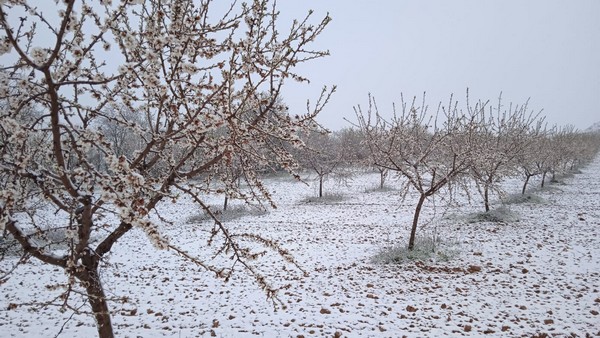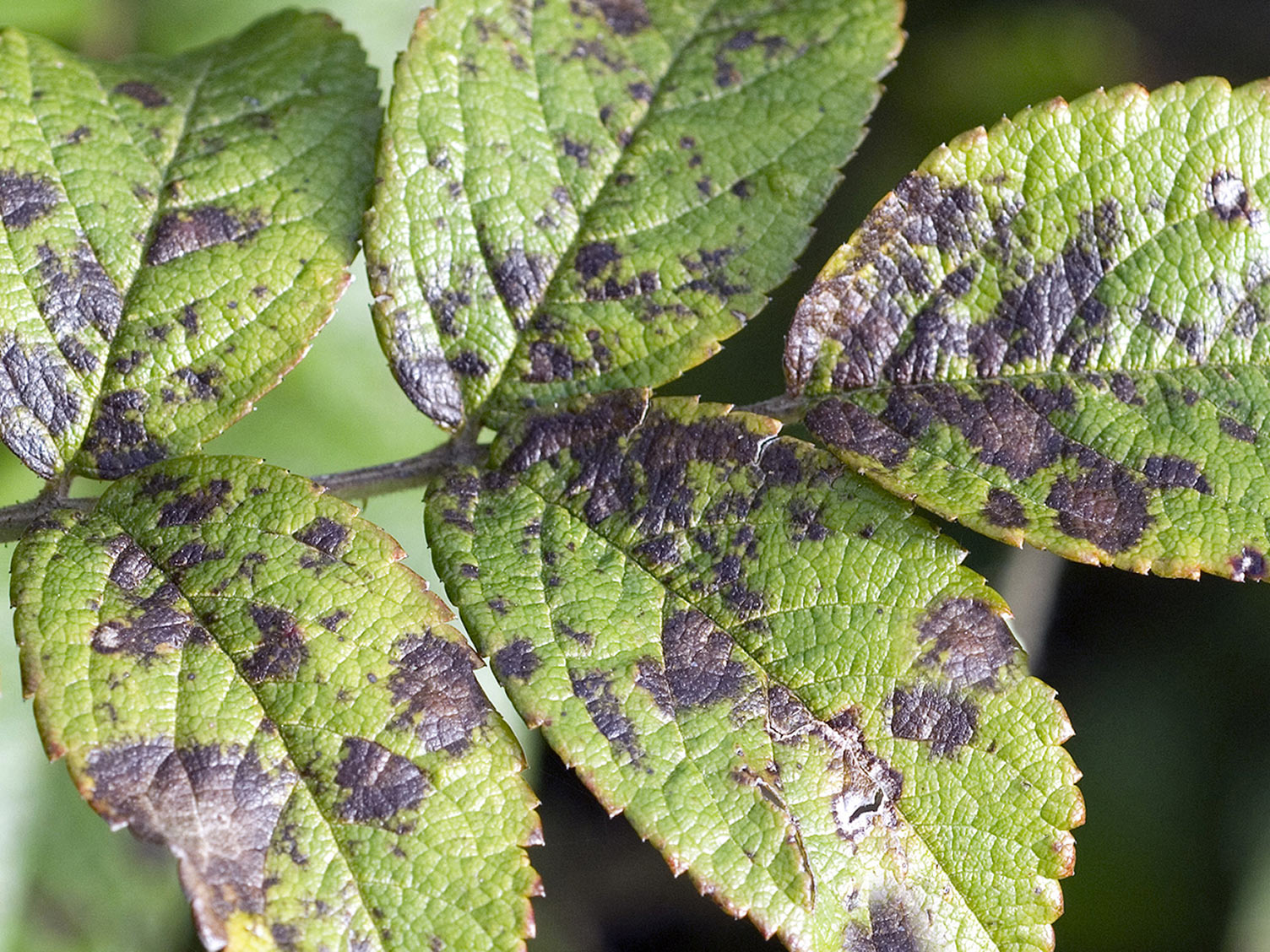I] In the USA, the rainy disturbance moves towards the south, favorable for drying the west of the CornBelt.
The next 10 days will be dry in the central and western CornBelt ①, which is good for reducing the problem of excess water in the soil. 2010 and 2013 allow us to consider two scenarios for this year. In 2013, high soil moisture ② associated with low temperatures ③ led on May 10 to corn planting delays of about 40 percent points compared to averages (28% vs. 65% on average). In 2010, soil moisture was very high in March but decreased in the following weeks ④, associated with near normal temperatures ⑤. As a result, on May 10th 2010, no seeding delays were observed, with 81% of the corn planted. At present, it seems that the 2019 momentum is closer to 2010, which would reduce the concern. But nothing is played yet and the greatest attention will be given to changing conditions.
 II] In the US, the unusually high snow depth in the spring wheat area is melting.
II] In the US, the unusually high snow depth in the spring wheat area is melting.
The snow depth map of March 30th highlights significant coverage in an area accounting for 45% of spring wheat acreage, consisting of eastern North Dakota, northern South Dakota and western Minnesota ①. The evolution of the temperatures on the rise in the last weeks ②, with values today close to the normals, allowed a fast melting of the snow. As of March 15th, the thicknesses were estimated to be close to 75 cm ③. They are estimated to be 2 cm on April 15th, at a level corresponding to the normal of season ④. This trend is favorable for less concern about spring wheat planting delays (80% sown in May in North Dakota). Soil moisture is still high, and as in CornBelt, we will continue to monitor closely the changing conditions in the area.
 III] In Europe, the dry trend in the south is continuing, and the concern is growing.
III] In Europe, the dry trend in the south is continuing, and the concern is growing.
Precipitation in early April is expected to be between 20 and 80 percent below normal throughout southern Europe ①. Spain, Italy and France are concerned in the West. In the South East of Europe, the problem extends to Hungary, Serbia, Romania, Bulgaria and Ukraine ②. The observation of soil moisture levels highlights the critical situation, with values much lower than the averages and the last years ③. The recovery of vegetation at the end of winter is not yet disturbed, but the vegetation indices could denote a degradation from the end of April, when the water needs of the crops will be important.
 IV] In Europe, more precisely in Spain, the early crops of the south of the country are impacted.
IV] In Europe, more precisely in Spain, the early crops of the south of the country are impacted.
Vegetation indices in southern Spain remain fairly close to averages, but in some areas indicate the tense situation for crops ①. The curve of vegetation indices shows us that durum wheat, currently in the heading stage, seems to be penalized by the unfavorable conditions ②. Soil moisture levels, particularly low, are of concern for the development of durum yield this season ③.
 V] In Brazil, a dry trend is underway in the south, but the cold moderates the issue.
V] In Brazil, a dry trend is underway in the south, but the cold moderates the issue.
In the center of the country, precipitation forecast for early April is above normal ①. The situation remains favorable for crops. In Paraná (20% of total safrinha corn production) and Mato Grosso do Sul (15% of total safrinha corn production), a dry trend is in progress ②, while crops have high water requirements (blooming stage). In view of the cumulative precipitation since January in Paraná ③, the dry is not yet at a very worrying level, especially as cool temperatures moderate the water needs of plants. Vegetation indices are indicative of the ahead of time crop development, and the current good vigor of plants ④. The values are about to reach a plateau, which will characterize the corn blooming peaks (currently in Paraná, 22% of the crops are in the flowering stage and 14% in grain filling).
 VI] In Brazil, vegetation indices in some areas show a development ahead of time of almost 20 days.
VI] In Brazil, vegetation indices in some areas show a development ahead of time of almost 20 days.
Vegetation indices of the last 10 days, above average on the vast majority of the Safrinha corn zone ①, reflect excellent crop vigor and a considerable early growing in development this year. Depending on the zone, we are 10 to 20 days ahead of time compared to last year ②. We estimate Brazilian corn production at 93.9 MT.
 VII] In Argentina, vegetation indices indicate the good vigor of late crops.
VII] In Argentina, vegetation indices indicate the good vigor of late crops.
Vegetation indices are above the 5-year average over most of the corn and soybean area ①. The NDVI curves show us a growing gap with the average values at the end of the cycle ②, a sign of a recovery in crop vigor and therefore a strengthening of yield potential. This is particularly true for late-season crops, with 48% of late soybeans at the early stage of grain filling and 50% of late maize at the late stage of grain filling / early maturation. The cumulative rainfall since January shows values above average and recent years ③, despite a slight dry trend over the last 3 weeks. The outlook remains good, our production estimates are 47.9 MT for corn and 55.8 MT for Soybean.
 VIII] In South Africa, favorable conditions are expected in the coming days.
VIII] In South Africa, favorable conditions are expected in the coming days.
After a month of February marked by a hot and dry trend, conditions are expected to improve in the country. Above normal rains are expected throughout the corn area ①, with near normal temperatures ②. These conditions will be favorable for the end of the crop cycle, mainly at the end of grain filling or maturation.
 IX] In South Africa, vegetation indices are worse than last year, but much better than 2016.
IX] In South Africa, vegetation indices are worse than last year, but much better than 2016.
The West of North-West state, West of Free State, and much of Mpumalanga have degraded vegetation indices ①. However, most of the corn area continues to show above average vigor ②. NDVI curves show a yield potential that is much lower than last year, but significantly higher than in 2016 and 2015 ③. The expected rainfall in the coming days will be positive for crops and is approaching the dynamics of 2018. Which will allow perhaps as in 2018 ④ a favorable lengthening of the end of cycle. We maintain our production estimate at 11.3 MT.
 X] In Australia, the water situation remains tense at a few weeks of sowing.
X] In Australia, the water situation remains tense at a few weeks of sowing.
Rainfall in the last 30 days has been above normal in southern Western Australia and around the Queensland / New South Wales border ①. Apart from these areas, the dry trend is maintained over most of the territory ②. The cumulative precipitation since January is lower than last year in South Australia ③, but also in Northern Western Australia, Victoria and Southern New South Wales. More rains will be needed, while planting will start in the second half of April and will continue in May ④.
 Source - https://www.geosys.com
Source - https://www.geosys.com
 II] In the US, the unusually high snow depth in the spring wheat area is melting.
The snow depth map of March 30th highlights significant coverage in an area accounting for 45% of spring wheat acreage, consisting of eastern North Dakota, northern South Dakota and western Minnesota ①. The evolution of the temperatures on the rise in the last weeks ②, with values today close to the normals, allowed a fast melting of the snow. As of March 15th, the thicknesses were estimated to be close to 75 cm ③. They are estimated to be 2 cm on April 15th, at a level corresponding to the normal of season ④. This trend is favorable for less concern about spring wheat planting delays (80% sown in May in North Dakota). Soil moisture is still high, and as in CornBelt, we will continue to monitor closely the changing conditions in the area.
II] In the US, the unusually high snow depth in the spring wheat area is melting.
The snow depth map of March 30th highlights significant coverage in an area accounting for 45% of spring wheat acreage, consisting of eastern North Dakota, northern South Dakota and western Minnesota ①. The evolution of the temperatures on the rise in the last weeks ②, with values today close to the normals, allowed a fast melting of the snow. As of March 15th, the thicknesses were estimated to be close to 75 cm ③. They are estimated to be 2 cm on April 15th, at a level corresponding to the normal of season ④. This trend is favorable for less concern about spring wheat planting delays (80% sown in May in North Dakota). Soil moisture is still high, and as in CornBelt, we will continue to monitor closely the changing conditions in the area.
 III] In Europe, the dry trend in the south is continuing, and the concern is growing.
Precipitation in early April is expected to be between 20 and 80 percent below normal throughout southern Europe ①. Spain, Italy and France are concerned in the West. In the South East of Europe, the problem extends to Hungary, Serbia, Romania, Bulgaria and Ukraine ②. The observation of soil moisture levels highlights the critical situation, with values much lower than the averages and the last years ③. The recovery of vegetation at the end of winter is not yet disturbed, but the vegetation indices could denote a degradation from the end of April, when the water needs of the crops will be important.
III] In Europe, the dry trend in the south is continuing, and the concern is growing.
Precipitation in early April is expected to be between 20 and 80 percent below normal throughout southern Europe ①. Spain, Italy and France are concerned in the West. In the South East of Europe, the problem extends to Hungary, Serbia, Romania, Bulgaria and Ukraine ②. The observation of soil moisture levels highlights the critical situation, with values much lower than the averages and the last years ③. The recovery of vegetation at the end of winter is not yet disturbed, but the vegetation indices could denote a degradation from the end of April, when the water needs of the crops will be important.
 IV] In Europe, more precisely in Spain, the early crops of the south of the country are impacted.
Vegetation indices in southern Spain remain fairly close to averages, but in some areas indicate the tense situation for crops ①. The curve of vegetation indices shows us that durum wheat, currently in the heading stage, seems to be penalized by the unfavorable conditions ②. Soil moisture levels, particularly low, are of concern for the development of durum yield this season ③.
IV] In Europe, more precisely in Spain, the early crops of the south of the country are impacted.
Vegetation indices in southern Spain remain fairly close to averages, but in some areas indicate the tense situation for crops ①. The curve of vegetation indices shows us that durum wheat, currently in the heading stage, seems to be penalized by the unfavorable conditions ②. Soil moisture levels, particularly low, are of concern for the development of durum yield this season ③.
 V] In Brazil, a dry trend is underway in the south, but the cold moderates the issue.
In the center of the country, precipitation forecast for early April is above normal ①. The situation remains favorable for crops. In Paraná (20% of total safrinha corn production) and Mato Grosso do Sul (15% of total safrinha corn production), a dry trend is in progress ②, while crops have high water requirements (blooming stage). In view of the cumulative precipitation since January in Paraná ③, the dry is not yet at a very worrying level, especially as cool temperatures moderate the water needs of plants. Vegetation indices are indicative of the ahead of time crop development, and the current good vigor of plants ④. The values are about to reach a plateau, which will characterize the corn blooming peaks (currently in Paraná, 22% of the crops are in the flowering stage and 14% in grain filling).
V] In Brazil, a dry trend is underway in the south, but the cold moderates the issue.
In the center of the country, precipitation forecast for early April is above normal ①. The situation remains favorable for crops. In Paraná (20% of total safrinha corn production) and Mato Grosso do Sul (15% of total safrinha corn production), a dry trend is in progress ②, while crops have high water requirements (blooming stage). In view of the cumulative precipitation since January in Paraná ③, the dry is not yet at a very worrying level, especially as cool temperatures moderate the water needs of plants. Vegetation indices are indicative of the ahead of time crop development, and the current good vigor of plants ④. The values are about to reach a plateau, which will characterize the corn blooming peaks (currently in Paraná, 22% of the crops are in the flowering stage and 14% in grain filling).
 VI] In Brazil, vegetation indices in some areas show a development ahead of time of almost 20 days.
Vegetation indices of the last 10 days, above average on the vast majority of the Safrinha corn zone ①, reflect excellent crop vigor and a considerable early growing in development this year. Depending on the zone, we are 10 to 20 days ahead of time compared to last year ②. We estimate Brazilian corn production at 93.9 MT.
VI] In Brazil, vegetation indices in some areas show a development ahead of time of almost 20 days.
Vegetation indices of the last 10 days, above average on the vast majority of the Safrinha corn zone ①, reflect excellent crop vigor and a considerable early growing in development this year. Depending on the zone, we are 10 to 20 days ahead of time compared to last year ②. We estimate Brazilian corn production at 93.9 MT.
 VII] In Argentina, vegetation indices indicate the good vigor of late crops.
Vegetation indices are above the 5-year average over most of the corn and soybean area ①. The NDVI curves show us a growing gap with the average values at the end of the cycle ②, a sign of a recovery in crop vigor and therefore a strengthening of yield potential. This is particularly true for late-season crops, with 48% of late soybeans at the early stage of grain filling and 50% of late maize at the late stage of grain filling / early maturation. The cumulative rainfall since January shows values above average and recent years ③, despite a slight dry trend over the last 3 weeks. The outlook remains good, our production estimates are 47.9 MT for corn and 55.8 MT for Soybean.
VII] In Argentina, vegetation indices indicate the good vigor of late crops.
Vegetation indices are above the 5-year average over most of the corn and soybean area ①. The NDVI curves show us a growing gap with the average values at the end of the cycle ②, a sign of a recovery in crop vigor and therefore a strengthening of yield potential. This is particularly true for late-season crops, with 48% of late soybeans at the early stage of grain filling and 50% of late maize at the late stage of grain filling / early maturation. The cumulative rainfall since January shows values above average and recent years ③, despite a slight dry trend over the last 3 weeks. The outlook remains good, our production estimates are 47.9 MT for corn and 55.8 MT for Soybean.
 VIII] In South Africa, favorable conditions are expected in the coming days.
After a month of February marked by a hot and dry trend, conditions are expected to improve in the country. Above normal rains are expected throughout the corn area ①, with near normal temperatures ②. These conditions will be favorable for the end of the crop cycle, mainly at the end of grain filling or maturation.
VIII] In South Africa, favorable conditions are expected in the coming days.
After a month of February marked by a hot and dry trend, conditions are expected to improve in the country. Above normal rains are expected throughout the corn area ①, with near normal temperatures ②. These conditions will be favorable for the end of the crop cycle, mainly at the end of grain filling or maturation.
 IX] In South Africa, vegetation indices are worse than last year, but much better than 2016.
The West of North-West state, West of Free State, and much of Mpumalanga have degraded vegetation indices ①. However, most of the corn area continues to show above average vigor ②. NDVI curves show a yield potential that is much lower than last year, but significantly higher than in 2016 and 2015 ③. The expected rainfall in the coming days will be positive for crops and is approaching the dynamics of 2018. Which will allow perhaps as in 2018 ④ a favorable lengthening of the end of cycle. We maintain our production estimate at 11.3 MT.
IX] In South Africa, vegetation indices are worse than last year, but much better than 2016.
The West of North-West state, West of Free State, and much of Mpumalanga have degraded vegetation indices ①. However, most of the corn area continues to show above average vigor ②. NDVI curves show a yield potential that is much lower than last year, but significantly higher than in 2016 and 2015 ③. The expected rainfall in the coming days will be positive for crops and is approaching the dynamics of 2018. Which will allow perhaps as in 2018 ④ a favorable lengthening of the end of cycle. We maintain our production estimate at 11.3 MT.
 X] In Australia, the water situation remains tense at a few weeks of sowing.
Rainfall in the last 30 days has been above normal in southern Western Australia and around the Queensland / New South Wales border ①. Apart from these areas, the dry trend is maintained over most of the territory ②. The cumulative precipitation since January is lower than last year in South Australia ③, but also in Northern Western Australia, Victoria and Southern New South Wales. More rains will be needed, while planting will start in the second half of April and will continue in May ④.
X] In Australia, the water situation remains tense at a few weeks of sowing.
Rainfall in the last 30 days has been above normal in southern Western Australia and around the Queensland / New South Wales border ①. Apart from these areas, the dry trend is maintained over most of the territory ②. The cumulative precipitation since January is lower than last year in South Australia ③, but also in Northern Western Australia, Victoria and Southern New South Wales. More rains will be needed, while planting will start in the second half of April and will continue in May ④.
 Source - https://www.geosys.com
Source - https://www.geosys.com













